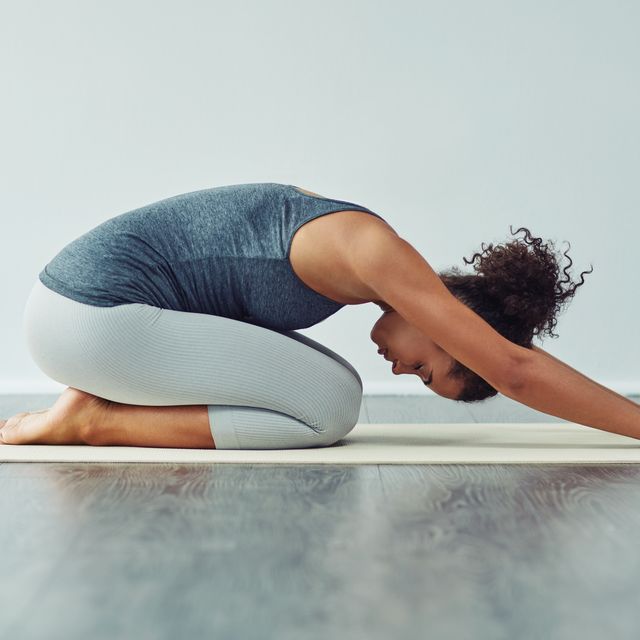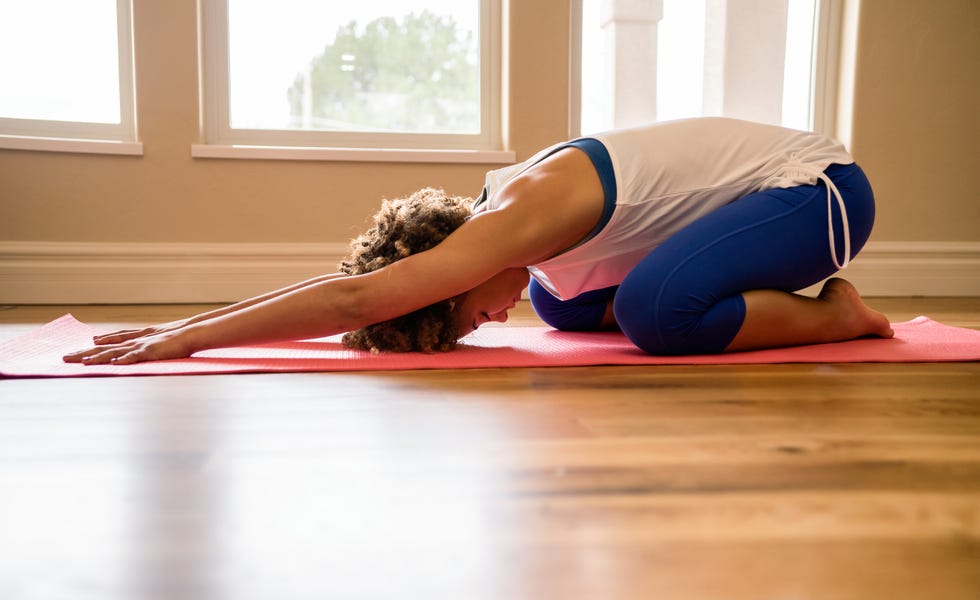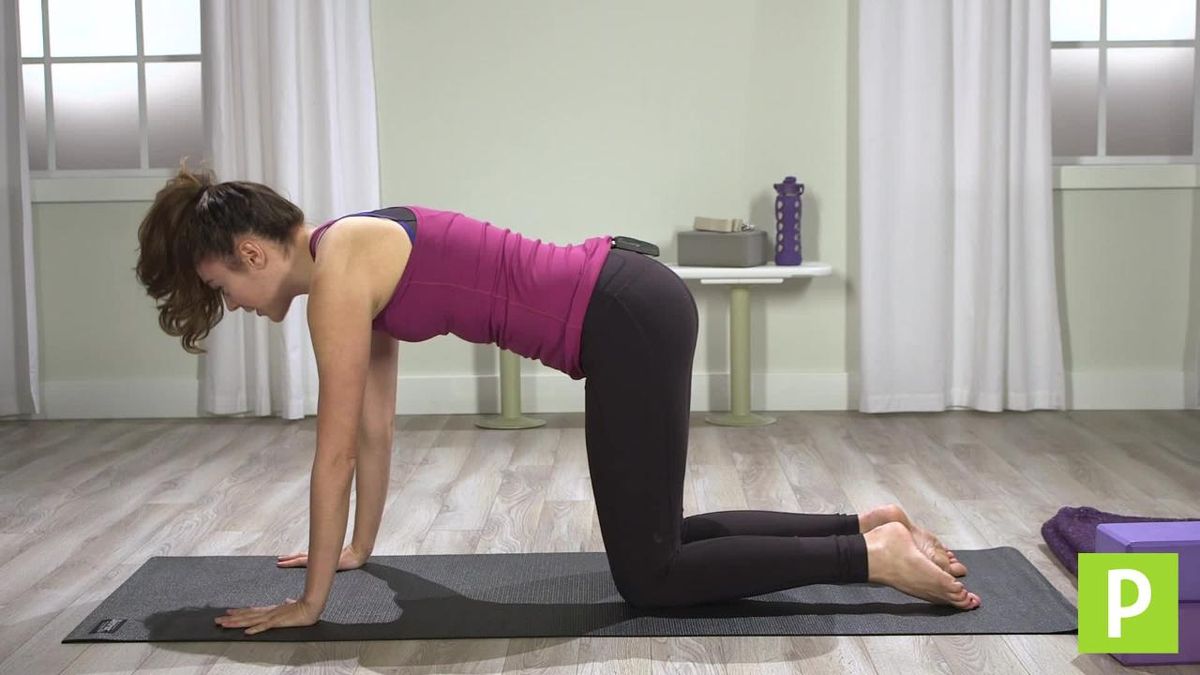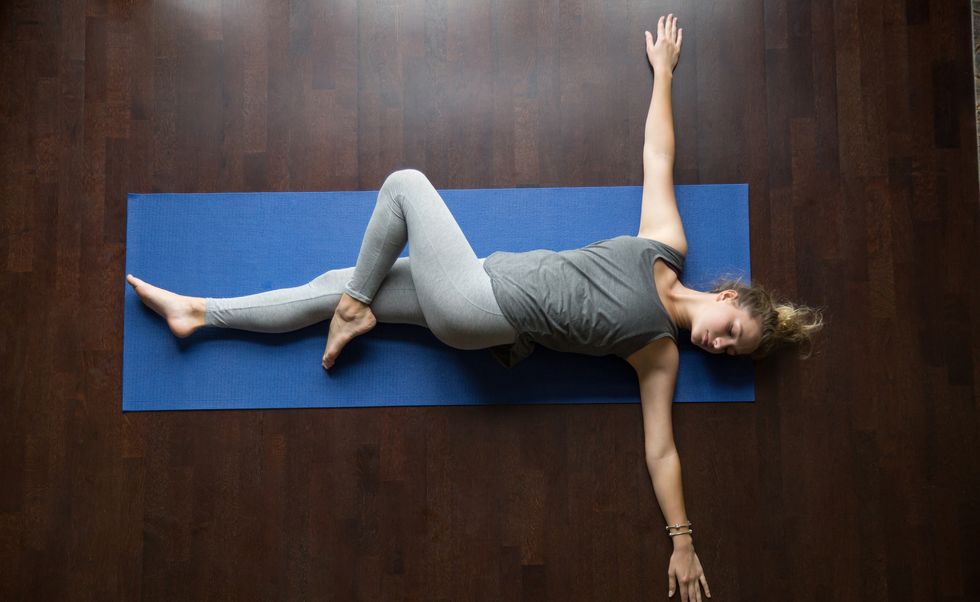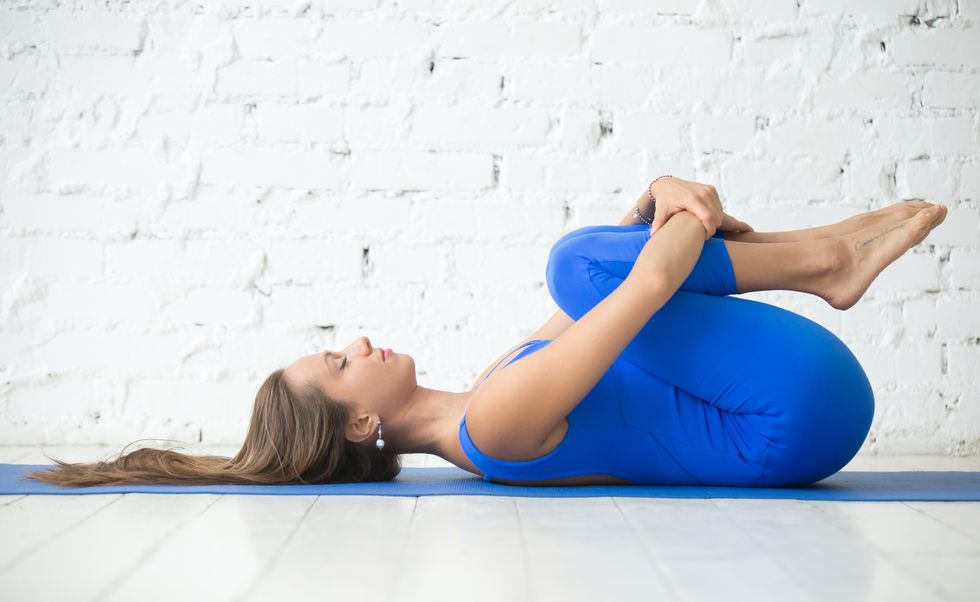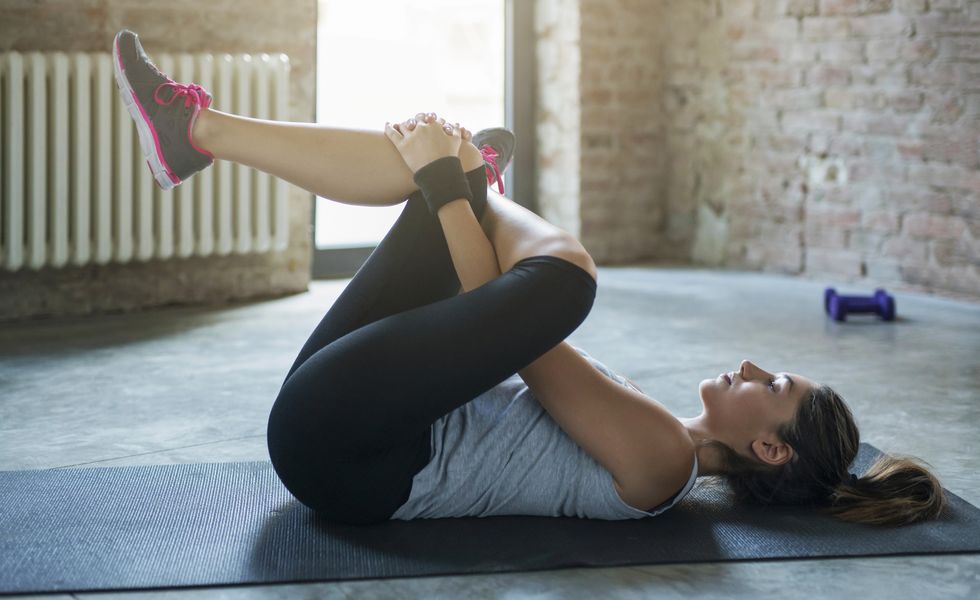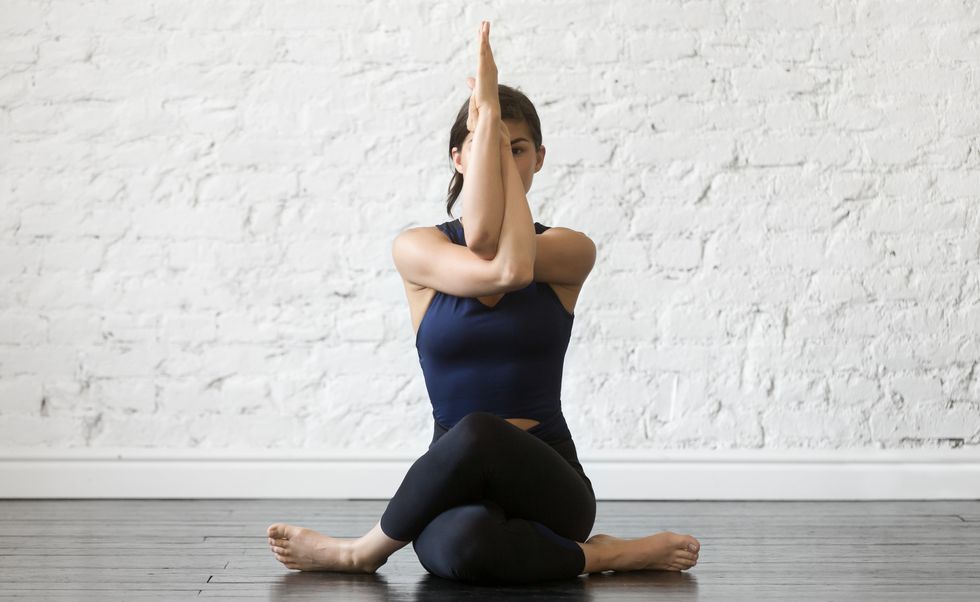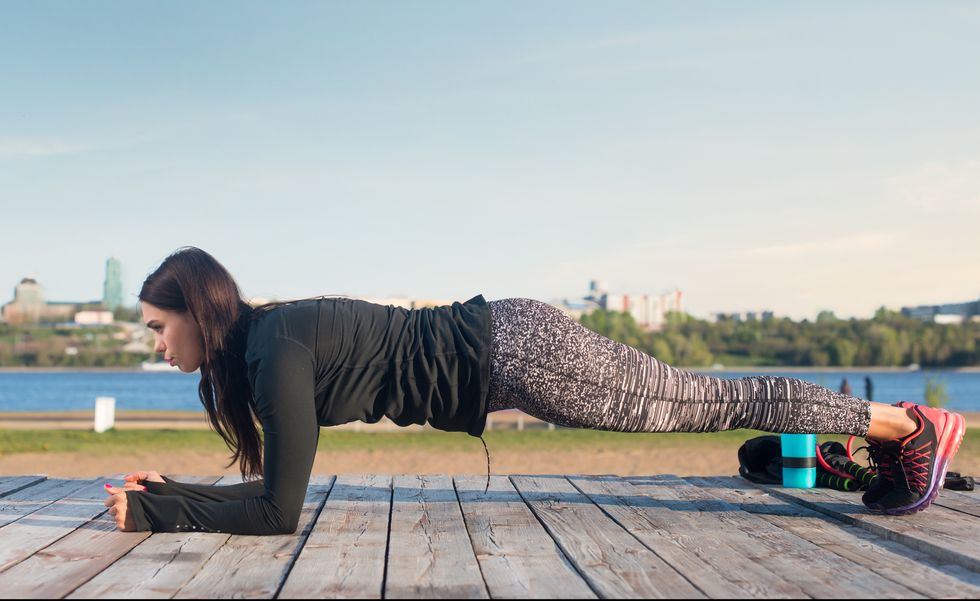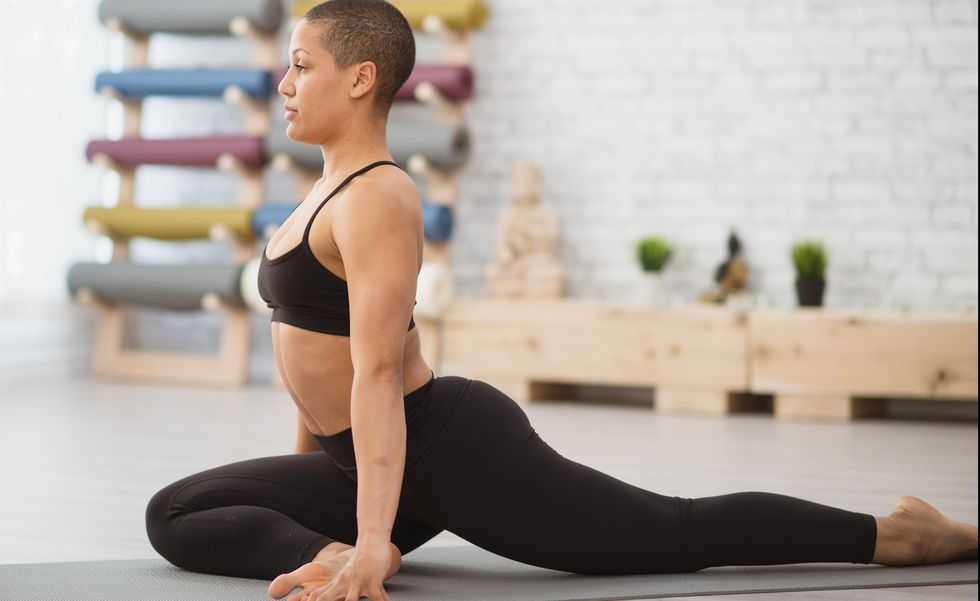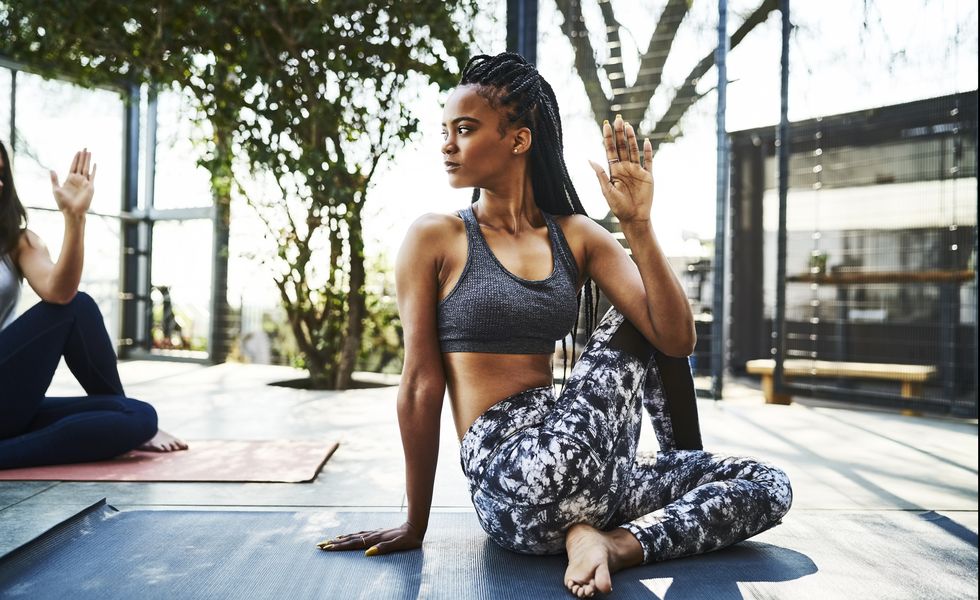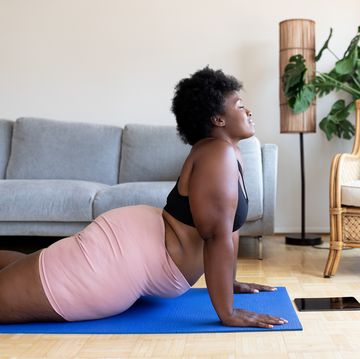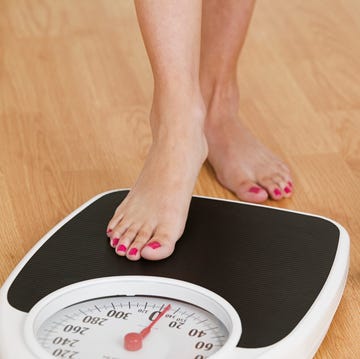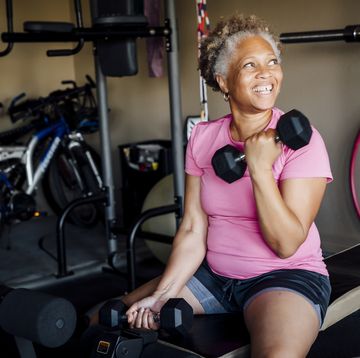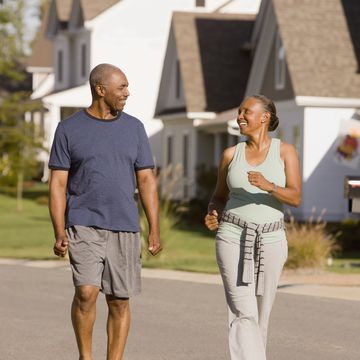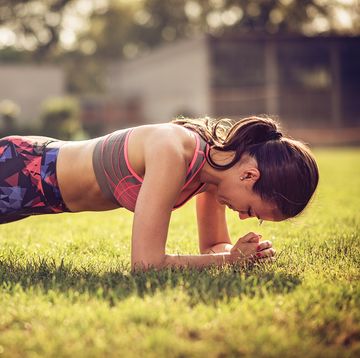Lower back tension can easily land you in bed with a stiffening inability to get up, but research shows that stretches for lower back pain can help prevent and ease discomfort, especially when performed two to three times a week. It’s important, of course, to listen to your body and tread lightly as not to injure yourself further, though—which is why we chatted with experts to discover lower back stretches you can do safely at home to get back on your feet.
Meet the Experts: Jamie Costello M.S.C., fitness director at the Pritikin Longevity Center + Spa; Rami Hashish, Ph.D., D.P.T.; body performance and injury expert; Mike Teater, P.T., D.P.T., O.C.S., C.M.P.T., director of operations for FYZICAL Therapy & Balance Centers Portland; and Karen Litzy, P.T., D.P.T.; owner and physical therapist at Karen Litzy Physical Therapy.
Some helpful stretches you’ll find below may surprise you, as they focus on the hips and legs—but they’re all connected. And the most important thing is that you approach them with gentleness. Believe it or not, gentle stretching often provides the fastest relief, says Jamie Costello M.S.C., fitness director at the Pritikin Longevity Center + Spa. In addition, Rami Hashish, Ph.D., D.P.T., body performance and injury expert recommends implementing exercises that focus on core strength, posture, stability, and flexibility to help prevent and ease back pain.
How to stretch out your lower back
Here are some more specific expert-backed tips to finding relief safely:
- Stretch your lower back carefully, especially if you have an existing injury or other health concerns, and if you’re in pain, it’s best to consult your doctor before beginning a new type of exercise, Costello says.
- Consider if you are flexion sensitive (leaning forward creates pain) or extension sensitive (arching backward creates pain), says Karen Litzy, P.T., D.P.T., owner and physical therapist at Karen Litzy Physical Therapy. When beginning stretching, she suggests being extra careful when working through movements that are flection or extension-based.
- Aim to hold each stretch for at least 10 seconds and preferably 30 seconds or longer, Costello recommends. The pain-relieving benefits will increase the longer you hold these stretches.
- Rather than rush through the moves, Costello encourages turning on soothing music and using this stretching time as a chance to relax and renew.
- Don’t forget to breathe! It may sound silly, but Costello says focusing on using your breath can help you cope with any feelings of discomfort.
- In general, be sure to include other activities like walking in your every day along with these stretches, Litzy says.
Lower back stretches
Now, give these fail-safe lower back stretches a try.
1. Child’s Pose
This common yoga pose gently stretches the muscles of the low back, which are likely contracted if you’re in pain. Plus, Hashish says it can not only relax the lower back, but it can help open your hips. If you find you have issues with your hips, Litzy suggests bringing your knees wider apart and going as far as you comfortably can.
How to do a child’s pose: Begin in a tabletop position on your hands and knees, with your hands directly under your shoulders and knees under your hips. Extend your arms out in front of you, placing your palms flat on the floor. Slowly sit your hips back toward your heels, dropping your head and chest downward as your arms extend further and reach for the wall in front of you. If this stretch is too much, place a pillow under your belly to prop yourself up a bit and lessen the stretch of the low-back muscles. Hold this pose for 20 to 30 seconds or even longer.
2. Cat/Cow Stretch
This dynamic movement moves the low-back muscles in two directions and builds on the Child’s Pose to help lengthen contracted muscles and soothe soreness. It also can help increase core strength and overall balance, Hashish says. Litzy adds to be sure you focus on your pelvis, acting as if you have a tail that you want to stick toward the ceiling or tuck under you.
How to do a cat/cow stretch: Begin in a tabletop position on your hands and knees, with your hands directly under your shoulders and knees under your hips. Your spine should be parallel to the ground in this position. Then, round your back, stretching your mid-back between your shoulder blades—similar to how a cat stretches by rounding its back. Hold for five seconds, then relax and let your stomach fall downward as you gently arch your low back and hold here for another five seconds. Repeat these movements for 30 seconds or longer.
3. Supine Twist
This stretch not only helps to stretch your lower back but also your glutes, which can tighten when you’re experiencing low back pain, ultimately causing more pain. It’s also effective in improving overall spinal flexibility, Hashish says.
How to do a supine twist: Begin by lying on your back with your knees bent and feet flat on the floor. Extend your arms out to the side in a “T” position. Keep your shoulders on the ground as you gently roll both knees to one side. Stay here 20 to 30 seconds, then return your knees to the center and repeat on the other side. If the stretch is too much for you, place a pillow or stack of blankets under your knees when you twist to each side.
4. Knee-to-Chest Stretch
Similar to the other stretches on this list, this pose lengthens and stretches contracted low back muscles, Hashish says. Litzy adds that this is a great alternative if the child’s pose is too much on the hands and hips.
How to do knee-to-chest stretch: Begin by lying on your back with your knees bent and feet flat on the floor. Bring your hands to rest either behind your knees or right below your kneecaps. Slowly bring both knees toward your chest, using your hands to gently pull your knees. Hold here 20 to 30 seconds, and try rocking your hips side to side and up and down to help massage your low back, then return to starting position.
5. The Pelvic Tilt
When you’re suffering from lower back pain, you might feel as if your entire pelvic area is immovable. This stretch can help you start to bring some movement back to this area gently by relieving sciatica and strengthening abdominal muscles, Hashish says.
How to do a pelvic tilt: Begin by lying on a yoga mat with your knees bent and feet flat on the floor. Try to relax your low back, keeping it in a neutral position (which means you should feel a slight curve in your low back if you place the top of your hand under your back). Activate your core muscles and then flatten your low back against the floor by slightly tilting your pelvis upward. Repeat 12 to 15 times.
6. Supine Figure 4 Stretch
This classic yoga pose helps open up the hips as much as it is good for massaging your low back. “This pose stretches the outer glutes, as well as your piriformis, both of which can contribute to a tight lower back,” says Hillary Wright, adjunct professor of biology, anatomy, and physiology at Manhattan College. It’s an effective stretch to relieve pain and increase hip mobility, Hashish says.
How to do a supine figure 4 stretch: Lie on your back on a yoga mat with both knees bent and feet planted on the floor. Lift your right leg, flex your right foot and cross your right ankle over your left thigh. If this is enough stay here, or draw your left knee in and hold behind your left thigh to increase the intensity. Hold for 10 to 15 breaths and then switch to the other side.
7. Reclining Hand-to-Big Toe Stretch (Supta Padangusthasana)
“Tight hamstrings and adductors, also known as your inner thighs, can contribute to a tight lower back,” Wright explains. This pose stretches things out by loosening up the back of the legs, ankles, calves, and hamstrings, Hashish says. If you find you have shooting pain down one leg, this stretch may put too much tension on the leg and should be avoided, Litzy says.
How to do a reclining hand-to-big-toe stretch: Lie on your back and lift your right leg up towards your face.
Interlace your hands behind your thigh or calf, depending on how tight your hamstrings feel. Keep your opposite leg active and your opposite hip grounded. Your head and shoulders should stay on the ground. Hold for 10 breaths. Now, still keeping your opposite hip grounded, let your right leg lower out to the right. Only lower the right leg out to the side so far as you can without the opposite hip lifting up.
8. Cow-Face Pose (Gomukhasana)
This pose stretches your outer glutes, which can cause low back pain when they’re tight, says Wright. It can also ease tightness in the hips, ankles, shoulder, and chest, Hashish says.
How to do the cow-face pose: From a seated position, bring your left heel toward your right glute, with your left knee pointing straight in front of you. Now bring your right leg on top of your left, stacking your knees together so they are both facing straight ahead. It’s ok if they don’t stack directly on top of one another. Your feet should be on either side of you, toes pointing behind you. Keep your spine long by sitting up tall, or add a slight forward bend to increase intensity.
9. Bridge Pose
“Softening around your sacrum allows some tension around the low back to be released and lengthening through the sit bones encourages activation of the lower part of your gluteus maximus, which helps to support your low back, releasing pain and tension,” Wright says. Hashish adds it's an excellent stretch option for the chest and hips, all while strengthening the back, buttocks, and hamstrings.
How to do bridge pose: Lying on your back, bend your knees and plant both feet on the yoga mat. Be sure your feet are hip-width apart with your heels close to your glutes. Press into your feet to lift your hips. From here try to soften around your sacrum, and lengthen your sit bones toward your knees. Hold for 30 seconds.
10. Forearm Plank
Wright says this variation of the plank activates your core, which will help take some pressure out of your low back by strengthening the muscles around it.
How to do a forearm plank: From the top of a push-up position, drop your forearms onto the mat directly underneath your shoulders. You can interlace your hands or bring the forearms parallel to one another, depending on how your shoulders feel. Kick through the heels and engage your core. Hold for at least 30 seconds, working your way up to one minute.
11. Pigeon Pose
Tight hip flexors can lead to lower back pain, and one of the best ways to open up the hips is with an extended half-pigeon posture. Hashish notes it’s an effective mobility exercise and hip stretch. A small study of people with chronic back pain found that those who practiced yoga, including pigeon pose, for 8 weeks had a 9% reduction in their pain.
How to do pigeon pose: Starting in Downward-Facing Dog, inhale as you lift your right leg up towards the sky for Three-Legged Downward-Facing Dog. On your next exhale, bend the knee and place your right knee towards your right wrist. Lower your right shin so that it becomes parallel to the top of your mat (it may be at an angle depending on your hip flexibility, and that’s totally OK!) Gently slide your left leg back toward the end of your mat. Feel free to stay here, or you bend your arms at the top of your mat and lower your head onto the top of your hands. Stay for 7 to 10 breaths.
12. Half Lord of the Fishes (Ardha Matsyendrasana)
Also known as Seated Twist posture, Ardha Matsyendrasana helps improve posture and spinal mobility in those with lower back pain. Don’t allow your lower back to collapse as you perform this posture, and remember that a little goes a long way when twisting with lower back pain.
How to do half lord of the fishes posture: Sit with your legs extended out in front of you (dandasana). Lift your right leg and place your foot on the ground beside your left knee. Bend your left leg and place the left foot on the outside of your right hip. Ground down through your hip bones, and inhale as you find length through the spine. Hook your left elbow on your right knee as you place your right hand behind you, and gently twist. Stay for 5 to 8 breaths.
13. Happy Baby (Ananda Balasana)
A restorative posture, Happy Baby is great for inducing relaxation, all while opening up your hips to reduce lower back pain. It also relaxes the back muscles and helps loosen up the neck and shoulders, helping you find relief. Hashish adds it can be a helpful tool in stretching the groin. If you can’t quite reach your toes, Litzy suggests using a strap instead.
How to do happy baby posture: From a supine position with your back on your mat, bend the knees so that your heels appear to be stamping the ceiling. Grab the outside of your feet with both hands and hook your elbows to the insides of your knees. Flex your heels into your hands and stay stagnant or feel free to rock side to side to give your lower back a little massage.
Lower back pain causes
There are a few different ways you could injure your lower back, according to Mike Teater, P.T., D.P.T., O.C.S., C.M.P.T., director of operations for FYZICAL Therapy & Balance Centers Portland, who says the three most common causes of lower back pain include:
- Bulging or herniated disc that presses on a spinal nerve as it exits the spine.
- Arthritis or degenerative (collapsed) disc that results in reduced space where the nerves exit the spine.
- Movement or alignment problems of the sacroiliac joint (where the tailbone fits into the pelvis).
“People may present with one or a combination of these problems that are driving their lower back pain,” he says, adding that while each of these problems may respond well to a specific treatment program, it’s important to match those treatments to the root cause of the lower back pain to avoid making anything worse.
“For example, people with a disc problem commonly have increased symptoms when bending forward,” he explains. “These people tend to respond well to backbends.” On the other hand, he says that people who are suffering from arthritis or degenerative lower back pain tend to have more pain when standing or walking, so they see better results while bending forward and sitting.
“Improving hip mobility, core strength, and flexibility is also often helpful in reducing the aggravation of lower back pain,” Teater continues, adding that you’ll still need to discover the root cause of the pain, since backbends are likely to aggravate back pain in people with arthritis, while forward bending exercises are likely to aggravate symptoms in people with a disc problem.
“If you’re suffering from back pain and are unsure of its root cause, please see your primary physician or physical therapist to help you get on track to being pain-free.”
Is it safe to stretch the lower back if it hurts?
Before you begin stretching your lower back, Teater says you’ll first need to identify what movements offer the most relief from your symptoms. “Many times, loosening tight muscles by lying on a lacrosse ball or a tennis ball to press into a tight and tender muscle, will help to loosen the muscle before you stretch and help to relieve pain,” he says, adding that you should think of a tight muscle you want to stretch like a rubber band with a knot in the center.
“If you pull the rubber band, you stretch on either side of the knot. By loosening the knot before you stretch (i.e., lying on a tennis ball or lacrosse ball), you can get a better stretch through that muscle, which helps with pain relief and helps the joints close to that muscle to move better.”
However, Teater says that you shouldn’t assume that stretching alone will cure your lower back pain. “The activities listed above are great for relieving and managing your pain,” he says, adding that you won’t fully resolve your symptoms until you are able to correct muscle imbalances in your core, or make lifestyle changes to prevent further irritation.
When to see a doctor about lower back pain
If your pain hasn’t gone away for more than two weeks, you experience extreme pain or pain at rest, have a loss of sensation, have difficulty walking or moving your legs, or experience a bowel or bladder dysfunction, Hashish suggests checking in with your doctor as soon as possible.

Lauren Wellbank is a freelance writer based in the Lehigh Valley region of Pennsylvania. Her work has appeared in The Washington Post, Huffington Post, Martha Stewart Living, and more. She has three small children, a husband, and an over eager dog at home. When she's not writing she likes to work in her garden with her family.
